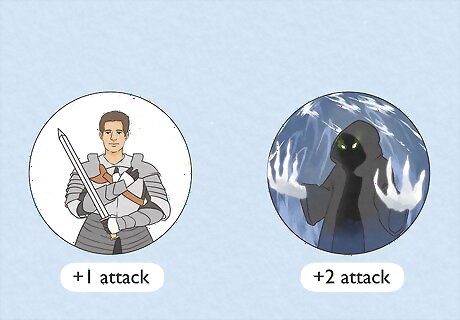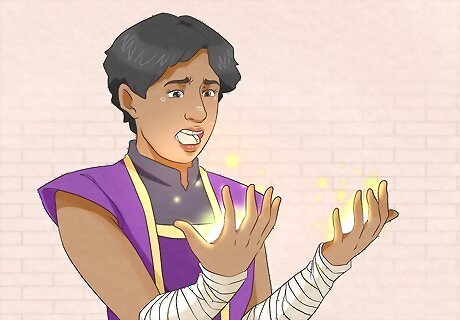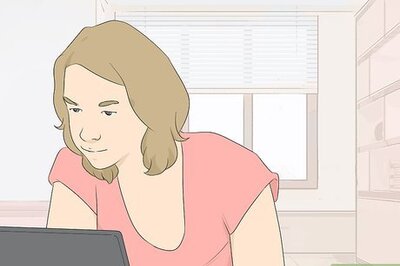
views
- Spirit Shroud grants all of your PC’s melee, ranged, and spell attacks an extra 1d8 damage, and you can choose between radiant, necrotic, and cold damage.
- Spirit Shroud also reduces enemies’ movement by 10 feet and prevents them from regaining any hit points, but it only affects creatures within 10 feet of your PC.
- Overall, Spirit Shroud is useful for PCs with the Extra Attack feature but not as effective as other spells (like Spirit Guardians, Hex, Bless, or Divine Smite).
What is the Spirit Shroud spell in D&D 5e?

Spirit Shroud is a 3rd-level spell that calls forth the spirits of the dead. Casting Spirit Shroud causes all of your player character’s (PC’s) attacks to deal an additional 1d8 whenever they hit a creature within 10 feet of themselves. You can choose for this damage to be radiant, necrotic, or cold damage, and after taking damage, the target creature can’t regain any hit points for a round (until the start of your PC’s next turn). Additionally, all creatures of your choice within 10 feet of your PC have their movement speed reduced by 10 feet until your next turn. Casting Time: 1 bonus action Range: Self Components: Verbal and somatic Duration: Concentration for up to 1 minute School: Necromancy Casting Spirit Shroud using a 4th-level spell slot or higher increases its damage by 1d8 for every two spell levels above 3rd. That means a 5th-level Spirit Shroud deals 2d8 damage, a 7th-level deals 3d8, and a 9th-level deals 4d8.
How does Spirit Shroud Wounds work?

Spirit Shroud applies to every attack you make, including spells. Some spells that augment attack damage only apply to your first attack—but Spirit Shroud affects all of them as long as it’s active. Every one of your melee, ranged, and spell attacks gets a bonus 1d8 points of damage from Spirit Shroud (and each attack can stop enemies from regenerating hit points), which is one of the spell’s big perks. Spirit Shroud also comes in handy because it works with spells that fire off multiple beams or rays, so long as attack rolls are involved! For example, the Scorching Ray spell shoots 3 separate rays of fire. Using Spirit Shroud with Scorching Ray would mean each individual ray of fire (which deal 2d6 damage) would also get a bonus 1d8 damage from Spirit Shroud—dealing significantly more damage than usual. However, Spirit Shroud doesn’t work with Magic Missile (even though it fires off at least 3 missiles at enemies) because that spell doesn’t require an attack roll.

The damage from Spirit Shroud only applies to the caster’s attacks. Casting Spirit Shroud won’t apply to any attack damage from your allies, creatures you’ve conjured, your PC’s Find Familiar companion (if you have one), or animated objects doing your bidding on the battlefield. In other words, only your melee, ranged, and spell attacks can benefit from Spirit Shroud when you cast it—nobody else’s. Remember that Spirit Shroud only counts toward attack rolls—so you can’t use it on spells with an area of effect that trigger saving throws from enemies (like Fireball).
How to Use Spirit Shroud

Cast Spirit Shroud when your PC’s class grants extra attacks. Spirit Shroud isn’t very convenient if you’re playing a spellcasting PC and prefer to stay far away from enemies. However, when you’re playing a martial character (like paladins, who specialize in melee combat), Spirit Shroud’s 10-foot range is no problem. It’s especially useful when your paladin PC gains the Extra Attack feature because you can benefit from the spell multiple times per round. For example, if you’re playing a paladin PC with the Extra Attack feature, you can take 2 attacks empowered with Spirit Shroud damage per turn (rather than 1), making the spell especially effective. All classes can take 1 attack per action by default, but martial classes (including fighters, rangers, paladins, and specialized subclasses like the College of Swords bard or Bladesinger wizard) get the Extra Attack feature as they level up.

Boost your multi-hit spells with Spirit Shroud. Spellcasters can also use Spirit Shroud because it applies to spells and physical weapon attacks! So, if you’re looking to add some more impact to your cleric, wizard, or warlock’s spells, Spirit Shroud can do the trick. It’s even better if you don’t mind keeping your spellcasting PC close to the action, within 10 feet of enemies, to take advantage of all the spell’s benefits. For example, if you’re playing a warlock PC and use the Eldritch Blast cantrip on an enemy, you can deal 1d10 damage (for Eldritch Blast) + 1d8 damage (for Spirit Shroud) to your target. That’s up to 18 points of damage in a single cantrip!

Stop enemies from healing or regenerating with Spirit Shroud. It can be aggravating when enemies manage to heal themselves with a spell or potion in combat—or when enemy healers start healing every other enemy on the battlefield! Try using Spirit Shroud to stop it; by targeting enemies with Spirit Shroud damage and preventing them from healing, you and your party can then focus your attacks on them and eliminate that enemy while they can’t heal! Spirit Shroud can also prevent enemies from regenerating. Some creatures (including vampires, trolls, and revenants) can naturally regenerate hit points without deliberately healing themselves—but Spirit Shroud blocks this ability. Keep in mind that temporary hit points don’t count as healing, so enemies can technically still get temporary hit points while affected by Spirit Shroud.

Slow enemies down and potentially make them waste a turn. Spirit Shroud can take 10 feet of movement away from enemies within range of the spell—which can be helpful if that enemy is trying to make a beeline for one of your allies. With their movement speed reduced, that enemy might not have enough movement to get to your ally in one round—meaning they’d have to dash or wait until their next turn to move the rest of the distance. Regardless, if an enemy doesn’t have enough movement to reach their target in a single round, at least one turn will likely get wasted—giving you extra time to eliminate that enemy.

Target creatures with radiant, necrotic, or cold damage vulnerability. One major perk of Spirit Shroud is the ability to choose between dealing radiant, necrotic, or cold damage to enemies. So, if you know the enemy you’re fighting is vulnerable to a specific type of damage, cast Spirit Shroud and target the enemy with that damage type to eliminate them faster. In D&D, enemies take double the damage when hit with a damage type they’re “vulnerable” to. For example, shadows are vulnerable to radiant damage—so if you come face-to-face with a pack of them, the radiant version of Spirit Shroud will deal double damage to them. Furthermore, radiant damage can cancel out specific abilities of undead creatures—like the zombie’s Undead Fortitude trait.
Is Spirit Shroud a good spell?

Spirit Shroud isn’t the best spell, but it may be helpful in specific cases. Overall, Spirit Shroud is “okay.” It’s not the worst spell in the game, but nowhere near the best, either. Certain classes (like paladins or subclasses that combine martial and spellcasting abilities) can use it better than others. However, better alternative spells exist for most classes—so Spirit Shroud might not be your first choice unless it fits your PC thematically better than other spells at their disposal. For example, Spirit Shroud can lead to some interesting roleplaying moments! Visually, it’s like summoning an army of spirits to buff your PC and wreak havoc on enemies. If you think that aesthetic fits your character, then Spirit Shroud might be a good choice. At the end of the day, though, Spirit Shroud probably isn’t the best choice if your priority is a perfectly optimized character build. Check out the section below if you’re unsure how it’ll work with your PC’s class!
Which classes can cast Spirit Shroud?

Clerics Clerics can cast Spirit Shroud—but would be better off with Spirit Guardians (which is another 3rd-level cleric spell). Spirit Shroud can’t compete with Spirit Guardians, especially since clerics are primarily spellcasters and don’t have the Extra Attack feature (one of the main reasons to use Spirit Shroud). Furthermore, Spirit Guardians deals more damage to a broader range of enemies, making it the more potent option for clerics. Spirit Guardians forces enemies within 15 feet of your PC to make a Wisdom saving throw. If they fail, they take 3d8 points of radiant damage and are considered slowed (or take half damage if they succeed). Since clerics don’t have an extra attack, Spirit Shroud only grants an extra 1d8 damage per turn—while Spirit Guardians deals up to 3d8. Comparatively, Spirit Guardians also has a better slow effect than Spirit Shroud. When you factor in Spirit Guardians’ higher damage output, the anti-healing effects of Spirit Shroud usually still aren’t worth it. Spirit Guardians is a cleric-only spell, however—so other classes capable of casting Spirit Shroud can’t use Spirit Guardians instead!

Paladins Paladins can use Spirit Shroud but might benefit more from a spell like Bless. Out of all the classes that can cast Spirit Shroud, paladins can benefit most from it since they have the Extra Attack feature. However, paladins can also cast the Bless spell, adding 1d4 to attack rolls. While Bless doesn’t apply to damage rolls, it does make paladins more likely to hit enemies (since that’s what attack rolls are for). So, if you have to choose a concentration spell to cast, Bless might be preferable to Spirit Shroud. Paladins also have the Divine Smite ability, which adds extra damage to attacks—and, if you cast Divine Smite at 3rd level, it’ll deal 4d8 points of radiant damage (compared to Spirit Shroud’s 1d8). In other words, you’d have to keep Spirit Shroud active (and keep dealing damage with attacks) for 4 rounds to do as much damage as you could do in a single round with Divine Smite. Since paladins have limited spell slots, spending them on Spirit Shroud might not be ideal when you could use them for Divine Smite instead!

Warlocks The only Warlock subclass that Spirit Shroud really works for is the Hexblade, since they get the Extra Attack feature and can make the most of Spirit Shroud’s damage bonus. On the other hand, other warlock subclasses won’t get as much from Spirit Shroud—mainly because they have access to the Hex spell. Hex is a 1st-level spell that lets you deal an extra 1d6 damage to your target per attack while also giving the target disadvantage on ability checks with one of their ability scores. Hex deals less damage than Spirit Shroud but lasts longer. It’s more effective for adding small amounts of damage over a day, while Spirit Shroud only lasts for a single fight. Since Hex has no radius (meaning it affects enemies over 10 feet away), it might be more convenient for your warlock than Spirit Shroud. Warlocks also have access to summoning spells like Summon Greater Demon and Danse Macabre—and creatures summoned from those spells can deal more damage per round than Spirit Shroud. Spirit Shroud’s 10-foot range also conflicts with the warlock’s Repelling Blast, an invocation that lets you push enemies away from your PC when casting Eldritch Blast. If you use Repelling Blast with Spirit Shroud active, you might end up pushing your enemy outside of the Spirit Shroud’s radius—and it won’t affect them anymore.

Wizards Like warlocks, Spirit Shroud only works for one wizard subclass: Bladesingers. Since Bladesingers get the Extra Attack feature, they can get more damage from Spirit Shroud. Still, wizards have the most extensive spell list of any spellcasting class in the game—so if your wizard isn’t a Bladesinger, there are too many other spells for wizard PCs that deal better damage (or have more potent debuffs) than Spirit Shroud. Stronger alternatives to Spirit Shroud include Fireball, Hypnotic Pattern, Web, Fear, Shatter, Erupting Earth, and Lightning Bolt. Eldritch Knights (a fighter subclass with access to wizard spells) can also use Spirit Shroud. However, because Eldritch Knights gain spell slots more slowly, they can’t use Spirit Shroud until they hit level 13. By level 13, Eldritch Knights also have access to more potent spells like Shadow Blade (which deals 2d8 psychic damage per hit) or Summon Fey (which summons a fey creature that can deal 2d6 damage per attack).
















Comments
0 comment